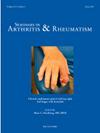The prognostic power of anti-topoisomerase I and anti-centromere antibodies in systemic sclerosis - A systematic review of the literature
IF 4.6
2区 医学
Q1 RHEUMATOLOGY
引用次数: 0
Abstract
Background
Anti-topoisomerase I antibodies (ATA) and anti-centromere antibodies (ACA) are the most prevalent systemic sclerosis (SSc) specific antibodies and are associated with distinct clinical phenotypes. This study reviews the prognostic potential of these autoantibodies for disease specific complications.
Methods
Literature searches of PubMed (MEDLINE), Embase, Web of Science and Cochrane Library were performed to identify longitudinal SSc-studies, reporting on the prognostic value of ATA and ACA for any aspect of survival or disease complications. After full text review, studies with <30 events of interest, <30 ACA positive and/or ATA positive patients, and with a moderate to high risk of bias (according to the QUIPS risk of bias tool) were excluded.
Results
Of 872 retrieved articles, 43 fulfilled the inclusion criteria. The included studies showed great heterogeneity in baseline characteristics and study design: mean baseline disease duration varied from 1 to 12 years and follow-up duration ranged from 1 to 18.1 years. One of the 21 studies found that ATA has prognostic value for mortality. Five of the nineteen available studies observed higher survival rates for ACA positive patients. Future development of ILD was associated with ATA in four of the seven studies, whereas ACA was associated with lower risk of ILD development in three out of four studies. For other disease outcomes, data are scarce.
Conclusion
In conclusion, there is little sound evidence to support an independent prognostic value of ATA and ACA for mortality in SSc. ATA is associated with future ILD development, while ACA decreases the risk of ILD development. To determine the possible role of ATA and/or ACA as biomarkers for every day clinical management and trial enrichment, future studies are warranted in well described cohorts in early SSc.
抗拓扑异构酶I和抗着丝粒抗体在系统性硬化症中的预后作用-文献系统综述
抗拓扑异构酶I抗体(ATA)和抗着丝粒抗体(ACA)是最常见的系统性硬化症(SSc)特异性抗体,与不同的临床表型相关。本研究回顾了这些自身抗体对疾病特异性并发症的预后潜力。方法对PubMed (MEDLINE)、Embase、Web of Science和Cochrane Library进行文献检索,以确定纵向ssc研究,报告ATA和ACA对生存或疾病并发症任何方面的预后价值。在全文审查后,排除了具有30个感兴趣事件、30例ACA阳性和/或ATA阳性患者以及中至高偏倚风险(根据QUIPS偏倚风险工具)的研究。结果872篇检索文献中,43篇符合纳入标准。纳入的研究显示基线特征和研究设计存在很大的异质性:平均基线疾病持续时间从1到12年不等,随访时间从1到18.1年不等。21项研究中的一项发现ATA对死亡率有预测价值。19项现有研究中有5项观察到ACA阳性患者的生存率更高。7项研究中有4项与ATA相关,而4项研究中有3项与ACA相关。对于其他疾病的结果,数据很少。结论目前尚无可靠证据支持ATA和ACA对SSc死亡率的独立预测价值。ATA与未来ILD的发展有关,而ACA降低ILD发展的风险。为了确定ATA和/或ACA作为日常临床管理和试验丰富的生物标志物的可能作用,未来的研究需要在早期SSc的良好描述的队列中进行。
本文章由计算机程序翻译,如有差异,请以英文原文为准。
求助全文
约1分钟内获得全文
求助全文
来源期刊
CiteScore
9.20
自引率
4.00%
发文量
176
审稿时长
46 days
期刊介绍:
Seminars in Arthritis and Rheumatism provides access to the highest-quality clinical, therapeutic and translational research about arthritis, rheumatology and musculoskeletal disorders that affect the joints and connective tissue. Each bimonthly issue includes articles giving you the latest diagnostic criteria, consensus statements, systematic reviews and meta-analyses as well as clinical and translational research studies. Read this journal for the latest groundbreaking research and to gain insights from scientists and clinicians on the management and treatment of musculoskeletal and autoimmune rheumatologic diseases. The journal is of interest to rheumatologists, orthopedic surgeons, internal medicine physicians, immunologists and specialists in bone and mineral metabolism.

 求助内容:
求助内容: 应助结果提醒方式:
应助结果提醒方式:


